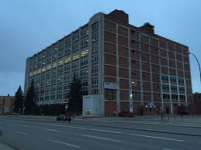The model city for transforming downtowns? It’s in Canada.
By the Editorial BoardMay 18, 2023
Almost every direction one looks in downtown Calgary, there’s a crane. The downtown transformation that so many other cities are desperate for is underway in Calgary, a city of 1.4 million in Alberta, which is often dubbed the “Texas of Canada” for its ties to the oil and gas industry. But today, office towers that once housed energy companies are rapidly being converted into apartments. Calgary offers a road map — and a tool kit — for D.C. and other beleaguered cities on how to make the switch rapidly and efficiently.
Calgary got a jump-start on its downtown metamorphosis because of the 2014 oil price crash. Initially, many believed the industry would bounce back, but by the time the coronavirus crisis hit, even the talk at Calgary’s Petroleum Club had turned toward how to reinvent the city.
The numbers were dire: Offices vacancies were at more than 30 percent. There weren’t just empty floors; there were empty towers. Fears spread of the city becoming the “next Detroit.” At City Hall, staff calculated that the value of downtown commercial buildings had nosedived from nearly 25 billion Canadian dollars in 2015 to about 9 billion Canadian dollars in 2021. (One Canadian dollar is worth about 75 cents.) Ultimately, it galvanized the community to take dramatic action.
The biggest takeaway is to go big and bold. Calgary launched its turnaround plan with 200 million Canadian dollars and a goal to invest 1 billion in the next decade. It included incentives of up to 75 Canadian dollars per square foot for developers, and — equally important — City Hall sped up the permitting process to less than two months. So many developers applied that it was akin to a bidding war.
Another lesson is the importance of broad community buy-in. Property mogul Hannes Kovac took over the city’s Real Estate Sector Advisory Committee at the end of 2020. He and co-chair Trent Edwards held their first meeting in January 2021. When they presented parts of the greater downtown plan to the City Council in April 2021, it was clear this wasn’t a real estate developer’s wish list; it was a community plan with input from retail, arts, nonprofits, government, businesses, education and more. The endorsement from so many sectors led to a 10-3 approval from the council.
The heart of the strategy was a big, yet simple, incentive program to transform offices into apartments to increase the number of downtown residents. Under the plan, developers submit bids to a newly created Downtown Strategy office. If approved, funds are set aside but developers don’t get the money until the building opens for residents. This puts the risk on the developer if a project fails.
As for permitting, “Our mantra is to move at the pace of business,” said Sheryl McMullen, manager of investment and marketing for the Downtown Strategy office.
Two years after Calgary’s council approved the turnaround plan, the city is nearly a quarter of the way to its goal of transforming 6 million square feet of office space into new uses, especially apartments. Calgary is largely a commuter city with many living in the suburbs and exiting quickly after work, creating a ghost town feel.
One transformed building already has residents living in it and is made up entirely of affordable housing. Eleven other office conversions are underway, with one set to open later this year. The initial round was so successful that the city quickly approved a second. Even more applications poured in, including from large national firms. Now there is a push to spur office conversions to hotels, schools and art centers, as well as demolition of buildings deemed too hard to transform.
Maxim Olshevsky, managing director of Peoplefirst Developments, is a Ukrainian immigrant who grew up a few blocks away from the office tower he is now transforming. He had watched Calgary’s “West End” deteriorate after the 2014 oil price slump. He knew the corner building at 909 5th Ave SW had been empty for years. He even sent an email of interest to his mortgage broker about it in 2018 because he saw the potential (his broker wasn’t enthusiastic at the time). But after the council approved the incentives, he bought it.
In his hard hat, Mr. Olshevsky walks through the building, dubbed the Cornerstone, pointing out the balconies and three-bedroom units for families he’s putting in. There’s already a waiting list of people interested in renting there. The project has gone so well that Mr. Olshevsky just announced he’s doing another conversion nearby. He plans to transform the city’s iconic Petro Fina building to make it a beacon of the city’s rising fortunes in a new era.
“Nothing is more attractive to investors and developers than the reduction of red tape,” Mr. Olshevsky said, praising the speedup of Calgary’s bureaucracy.
One of the controversial aspects of Calgary’s program is that it gives grants with no strings attached. There are no requirements for affordable housing. Projects such as Mr. Olshevsky’s aim for “attainable luxury” with about 40 percent below-market units. In a city where rents have shot up 25 percent in the past year, there’s a dire need for housing that the middle class, let alone families living paycheck to paycheck, can afford. Officials say so many developers have applied that the city has been able to be picky. Projects that aim to build larger, more reasonably priced units typically receive preference.
Calgary was also fortunate that at the same time the city approved the downtown plan, a nonprofit developer called HomeSpace, which specializes in affordable housing, put forward a proposal to transform an office building, too. (It received local, provincial and federal funding.) The project was completed in a miraculous 12 months and became Calgary’s first office-to-residential conversion to open. The Neoma building houses a homeless shelter on two floors and low-income housing on the rest. It’s bright and edgy, with large murals inside and out. Kids who live there even get to choose artwork donated from local artists to decorate their bedrooms. It’s heralded as an overwhelming success, but there are no other affordable conversion projects like it in the works. “Not everybody makes top dollar and can live in these million-dollar condos,” said Bernadette Majdell, chief executive of HomeSpace.
Momentum is palpable among builders and city officials who say the 10-year plan is ahead of even their most optimistic projections. The “East Village” side of downtown is thriving again, buoyed by Calgary’s Central Library, an architectural masterpiece that opened in late 2018 and continues to draw people of all ages. Sarah Meilleur, Calgary Public Library’s chief executive, said 86 percent of visitors are back at the central location. Arts centers and a college nearby are also humming again. It’s no longer a leap of faith to invest there.
It’s different on the west side of downtown, where many of the city’s conversion dollars are going. Riding Calgary’s free tram line west reveals more graffiti, boarded-up buildings and “for lease” signs, a jolt when viewed against the awe-inspiring Canadian Rockies in the distance. The small-business owners of Yara Flower Art and Daily King Convenience Store said they had not felt any uptick yet. There are pockets of hope — the Westley Hotel is housed in a recently converted office — but across the street are vacant buildings and a concrete lot where a construction company is keeping spare windows and dumpsters. Like many cities, Calgary has seen some increase in crime. A series of stabbings downtown in early April added to fears.
But almost everyone, even shop owners, said they were staying put because they can see movement.
Mayor Jyoti Gondek was a progressive council member in April 2021 when she voted in favor of the downtown transformation. Now, as mayor, she’s keeping in mind a warning from Houston leaders when she consulted them about revitalization: “People get antsy in the first year and they want results right away. You have to stay the course.”
The next task for Ms. Gondek is persuading the province to kick in funding for another university campus downtown. It has become a big issue in the upcoming Alberta provincial elections this month. But most expect some money will eventually come.
For now, Calgary’s leaders point to the cranes — and the emails and voice mails they’ve been getting from leaders in San Francisco and other U.S. cities — as a reminder they are doing a lot right. D.C. officials should be calling, too.
Link
Comments?


